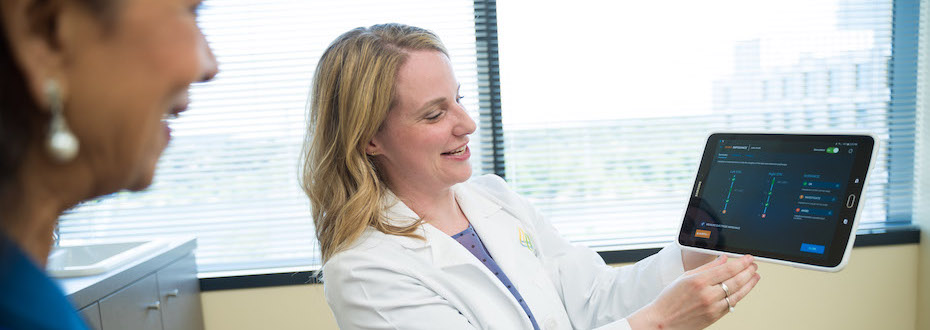DBS: Frequently Asked Questions and Resources

This page includes information to help you:
- Find answers to common questions about deep brain stimulation (DBS).
- Learn about possible risks and side effects of DBS.
- Find resources for Parkinson's disease and essential tremor patients.
Frequently asked questions about DBS
For patients with Parkinson's disease, our team sometimes places the electrodes on only one side of the brain. More often, we place electrodes on both sides. The electrodes are placed in the subthalamic nucleus or the globus pallidus internus.
For essential tremor patients, we place the electrodes in the brain’s thalamus area.
Every patient is different. But DBS greatly improves symptoms and quality of life for many patients. Symptoms that may improve include tremor, involuntary movements (dyskinesia), and stiffness or slowness caused by Parkinson’s disease. DBS won't make all movement symptoms go away entirely, though.
No. DBS won’t cure Parkinson’s disease or essential tremor, and it won’t slow the progression of either disease. The stimulator settings can be adjusted, however, to better control symptoms as your disease progresses.
Talk with your neurologist about specific activities. But after you recover from surgery, you should be able to take part in regular activities such as swimming, bathing, sexual activity or sports.
Parkinson's disease patients will not stop taking medication. They may reduce the amount of medication, with their neurologist’s guidance. Essential tremor patients may be able to reduce or stop many or all tremor medications.
Each patient is different. For most patients, benefits last many years. A study published in JAMA Neurology in 2011 found that Parkinson's patients still had significant improvement 10 years after DBS. Learn more about DBS outcomes.
No. You may feel brief tingling sensations when we make changes during programming appointments.
We create one or two small incisions in your skull. Each is smaller than a dime. After we place the electrodes, the openings are covered with small and secure caps that hair can grow over.
Yes. DBS is surgery, and all surgery has risks. With DBS, risks include possible stroke or speech problems.
But risks are generally low. A three-year analysis of U.S. academic health centers, including OHSU, studied the results from thousands of DBS procedures. It found that among 2,038 patients who had DBS, 72 had complications, and one died. Among the 219 patients who had DBS at OHSU during the study period, none died and one had complications.
DBS wires don’t show. The DBS system is completely under your skin. The implanted pulse generator (IPG) is about the size of a tea bag. We place it under your skin, right below your collarbone. The wires that connect the device to the electrodes in your brain are thinner than uncooked spaghetti. We place those wires under the skin of your head, neck and shoulders.
The outline of the IPG may be visible if you are undressed, especially if you are thin. It won’t show through clothing. The small caps in the skull create slight bumps, but they are usually covered by hair.
There can be. Many patients have no long-term side effects. Some have speech or balance problems. A DBS programmer or neurologist can adjust your IPG to reduce or stop side effects.
Keep in mind that DBS is not a cure. Your symptoms may change or get worse over time as your disease progresses. It is important to continue with physical and speech therapy even after DBS surgery.
It usually takes a few months for DBS to work as well as possible for you. We may need to program your IPG several times to get the full benefit.
You will get a programmer that allows you to turn your IPG on or off and check the battery level. Depending on your specific case, the programmer may let you make minor adjustments yourself.
Certain procedures can affect the DBS system, or cause potential health issues. For example, MRI (magnetic resonance imaging) can damage the DBS system. Your neurologist can adjust your DBS settings if you need an MRI.
You'll also want the system turned off during surgery. Make sure you tell your health care provider that you have a neurostimulation system.
Medicare covers DBS for some patients. Please consult with a Medicare representative or discuss it with our team.
Non-Medicare health insurance often covers DBS. Your surgeon's office usually has to get authorization from your insurance company before surgery. Your insurance company should be able to provide more details on its coverage and authorization process.
Resources for Parkinson’s disease patients
Websites with more information about DBS:
- Parkinson's Foundation
- American Association of Neurological Surgeons
- Michael J. Fox Foundation
- Medline Plus
- Medtronic
Information on Parkinson's disease and DBS research:
OHSU Resources:
Resources for essential tremor patients
Websites with more information:
OHSU Resources:
- Our complete DBS guide for essential tremor patients
- OHSU Parkinson's Disease and Movement Disorders Program
- DBS settings tracker
Support for out-of-town DBS patients:
Find information on arriving at OHSU for surgery.
The Rood Family Pavilion is a home away from home for patients and families from outside the Portland area. Staying here depends on availability. The pavilion is run in partnership with Ronald McDonald House Charities of Oregon and SW Washington.
For patients
Call 503-494-4314 to:
- Ask questions
- Arrange a referral from your neurologist
- Schedule follow-up appointments
Download our patient guides:
Location
Parking is free for patients and their visitors.
Center for Health & Healing
Building 1, eighth floor
3303 S. Bond Ave.
Portland, OR 97239
Map and directions
Refer a patient
- See our Referring Providers page to learn about making a referral to OHSU, how we partner with you, and training opportunities.
- Is your patient a candidate for DBS?
- Download our DBS guide for providers.
- Call 503-494-4567 to seek provider-to-provider advice.
DBS changed her life
Diane describes her experience with Parkinson's disease, DBS surgery and the effect treatment has had on her life in this StoryCorps conversation.